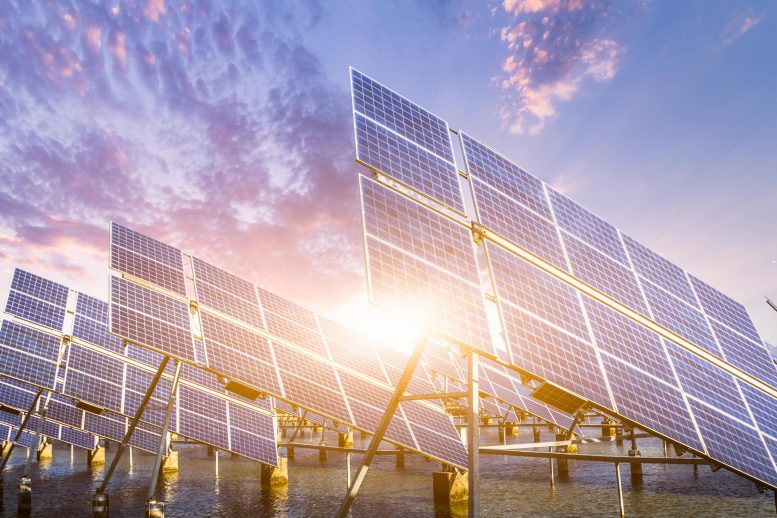
New research suggests that solar power is set to become the dominant energy source by 2050. While this shift promises a cleaner energy future, four main challenges could impede progress: the need for stable power grids, securing solar finance in developing countries, addressing supply chain demands, and overcoming political opposition from declining industries. Addressing these barriers is deemed more effective than financial tools like carbon taxes in advancing the clean energy transition.
The world may have crossed a “tipping point” that will inevitably make solar power our main source of energy, new research suggests.
The study, based on a data-driven model of technology and economics, finds that solar PV (photovoltaics) is likely to become the dominant power source before 2050 – even without support from more ambitious climate policies.
However, it warns four “barriers” could hamper this: the creation of stable power grids, financing solar in developing economies, capacity of supply chains, and political resistance from regions that lose jobs.
The researchers say policies resolving these barriers may be more effective than price instruments such as carbon taxes in accelerating the clean energy transition.
The study, led by the University of Exeter and University College London, is part of the Economics of Energy Innovation and System Transition (EEIST) project, funded by the UK Government’s Department for Energy Security and Net Zero and the Children’s Investment Fund Foundation (CIFF).
Redefining Energy Projections
“The recent progress of renewables means that fossil fuel-dominated projections are no longer realistic,” Dr Femke Nijsse, from Exeter’s Global Systems Institute. “In other words, we have avoided the ‘business as usual’ scenario for the power sector. However, older projections often rely on models that see innovation as something happening outside of the economy. In reality, there is a virtuous cycle between technologies being deployed and companies learning to do so more cheaply. When you include this cycle in projections, you can represent the rapid growth of solar in the past decade and into the future. Traditional models also tend to assume the ‘end of learning’ at some point in the near future – when in fact we are still seeing very rapid innovation in solar technology. Using three models that track positive feedback, we project that solar PV will dominate the global energy mix by the middle of this century. However, the researchers warn that solar-dominated electricity systems could become “locked into configurations that are neither resilient nor sustainable, with a reliance on fossil fuel for dispatchable power.”
Addressing the Barriers
Instead of trying to bring about the solar transition in itself, governments should focus policies on overcoming the four key “barriers”:
- Grid resilience: Solar generation is variable (day/night, season, weather) so grids must be designed for this. Dr Nijsse said: “If you don’t put the processes in place to deal with that variability, you could end up having to compensate by burning fossil fuels.” She said methods of building resilience include investing in other renewables such as wind, transmission cables linking different regions, extensive electricity storage, and policy to manage demand (such as incentives to charge electric cars at non-peak times). Government subsidies and funding for R&D are important in the early stages of creating a resilient grid, she added.
- Access to finance: Solar growth will inevitably depend on the availability of finance. At present, low-carbon finance is highly concentrated in high-income countries. Even international funding largely favors middle-income countries, leaving lower-income countries – particularly those in Africa – deficient in solar finance despite the enormous investment potential.
- Supply chains: A solar-dominated future is likely to be metal- and mineral-intensive. Future demand for “critical minerals” will increase. Electrification and batteries require large-scale raw materials such as lithium and copper. As countries accelerate their decarbonization efforts, renewable technologies are projected to make up 40% of the total mineral demand for copper and rare earth elements, between 60 and 70% for nickel and cobalt, and almost 90% for lithium by 2040.
- Political opposition: Resistance from declining industries may impact the transition. The pace of the transition depends not only on economic decisions by entrepreneurs but also on how desirable policymakers consider it. A rapid solar transition may put at risk the livelihood of up to 13 million people worldwide working in fossil fuel industries and dependent industries. Regional economic and industrial development policies can resolve inequity and can mitigate risks posed by resistance from declining industries.
Commenting on the financial barrier, Dr. Nadia Ameli from UCL’s Institute for Sustainable Resources, said: “There is a growing belief that, with the dramatic decline in the global average cost of renewables, it will be much easier for the developing world to decarbonize.
“Our study reveals persistent hurdles, especially considering the challenges these nations face in accessing capital under equitable conditions.
“Appropriate finance remains imperative to expedite the global decarbonization agenda.”
Reference: “The momentum of the solar energy transition” by Femke J. M. M. Nijsse, Jean-Francois Mercure, Nadia Ameli, Francesca Larosa, Sumit Kothari, Jamie Rickman, Pim Vercoulen and Hector Pollitt, 17 October 2023, Nature Communications.
DOI: 10.1038/s41467-023-41971-7
The study was funded by the UK government – Department for Energy Security and Net Zero and the Children’s Investment Fund Foundation.
Later this year, during COP28, a research team led by the University of Exeter will publish the first Global Tipping Points Report, the most comprehensive ever assessment of climate tipping points and positive tipping points that could help tackle the climate crisis.









Point 1: Solar will remain (on Earth) a SECONDARY power source, NEVER a primary. Too many obstacles to be a reliable power output. Batteries to back them in times of no output are way too cumbersome, dangerous, and expensive in terms of both money AND resources.
Point 2: There is no real solution to ‘climate change” other than face up to the hoax.
Data driven model? You mean like “garbage in- garbage out?” That kind of model?
These people have an obvious lack of mathematical skills. Physics is beyond their comprehension.
“Data-driven model” is another way of saying “tea leaves told me”.
But seriously, should something like that become the reality – what’s it gonna do to the environment? Solar panels, once disposed of, are not really what you’d call “eco-friendly”.
Nonsense… you don’t have the batteries for storage and never will
Within 20-40 years, we will have satellites in Earth orbit that will capture Sol’s energy and beam it down to Earth.
So stupid. Solar will never go anywhere toward meeting the necessary dispatchable base-load power that a stable grid requires. It is next to worthless.
Exeter does realize that solar is not dispatchable, right? Cloudy day, no solar. A bit of snow, no solar. Behind on keeping the weeds down, or on cleaning off pollen, only a little solar.
The only thing stupider than solar is wind. Luckily we don’t need either. CO2 is STILL at starvation levels. The biosphere needs MORE CO2, not less. So just go ahead and build coal and gas fired electrical generation, and if we ever get to where we don’t need more CO2, switch to nukes.
I wonder what the carbon footprint of manufacturing a solar panel is? And how much fossil fuel is needed for the production and manufacture of panels?…don’t plants need CO2 to live and produce O2
Apparently no matter what we do we are heading for doom day!!!! However, if solar power is going to use all the minerals which, by the way, poorer nations have to pay for it as they are already doing to provide minerals for car batteries, should we not aim on how to capture carbon gas?
Any model that ignores the physics, geology and chemistry of the relevant competitors is useless. The model appears to be built on assumptions of a significant increase in photovoltaic efficiency and on the creation and large-scale deployment of vastly superior battery technology. It’s not at all clear that either is physically possible, much less that there is there a clear technological path to achieving either aim. As with so many of these models, it’s a political approach to the world that assumes the desires of the technically inept but well-connected will somehow be translated into reality by others.
Pure propaganda. Anyone with half a brain knows wind and solar will NEVER be a viable energy source. Anyone who believes a word of this delusional.